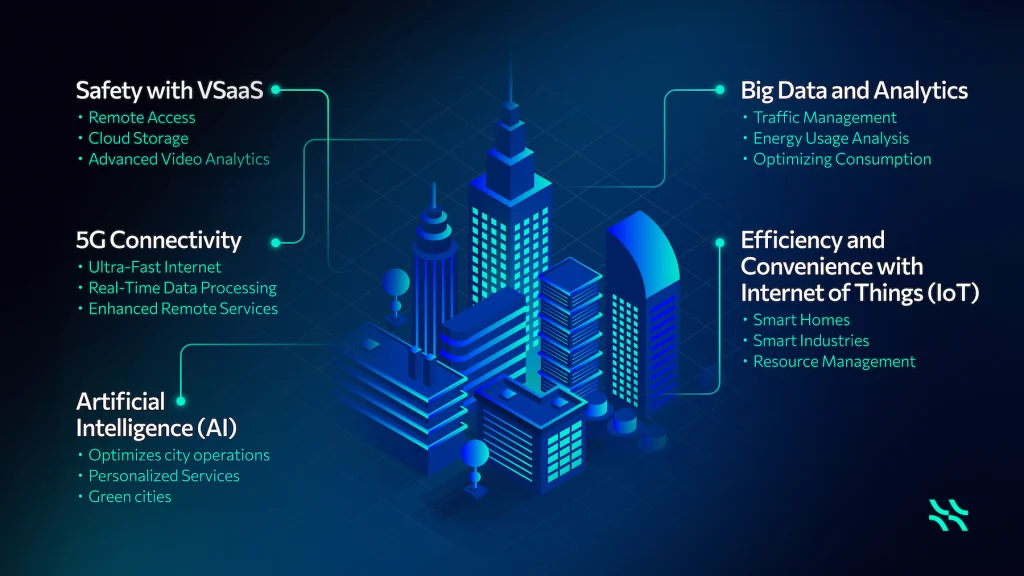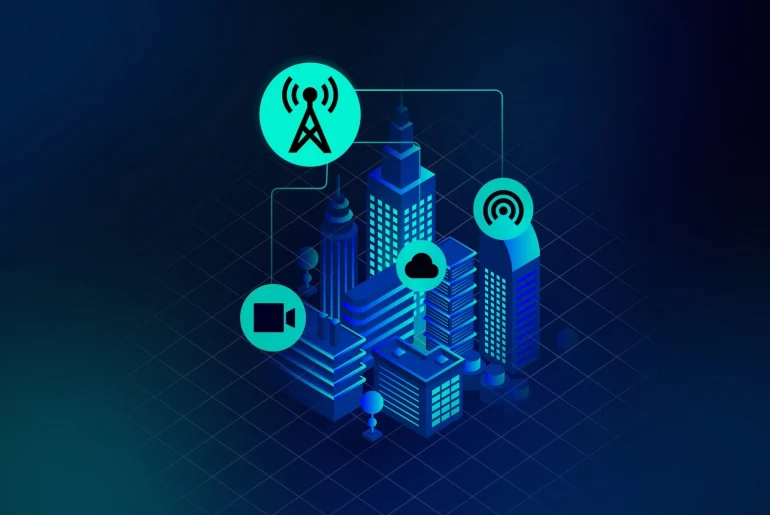Why telecoms became the key drivers who build smart cities
Smart cities offer a promising solution. Digital technologies integrated in urban environments aim to optimize resource allocation, improve infrastructure, and enhance the quality of life for their residents. The core concept is simple yet powerful: connectivity. So telecoms play a great role in it – telecoms build smart cities.
The Smart City Solution
Urbanisation is reshaping our world at an unprecedented pace. According to the United Nations, more than 68% of the world’s population is expected to live in cities by 2050. This rapid urban expansion presents a formidable challenge. How to manage the influx of people while ensuring sustainable, efficient, and livable cities?
At the heart of a smart city lies an intricate network of interconnected devices, sensors, and systems. This digital ecosystem enables real-time data collection and analysis, facilitating informed decision-making and proactive problem-solving.
What Is a Smart City? Defining the Concept and Technologies Involved
A smart city is more than just a buzzword. It’s a vision of urban living where technology seamlessly integrates with our daily lives. Smart cities are filled with a range of digital tools, sensors, and data-driven solutions to manage resources effectively, enhance security, and offer services. For example, they adapt smart traffic management, energy monitoring, and public safety.

Key technologies involved in smart cities infrastructure include:
- 5G Connectivity which is the heart rate of smart cities, providing high-speed, low-latency communication for connected devices. 5G enables real-time data transfer. It is essential for managing city infrastructure such as autonomous vehicles, smart traffic lights, and emergency response systems.
- Video Surveillance as a Service (VSaaS) provides efficient ways to monitor public spaces and improve security without the need for costly on-premise infrastructure. The Aipix VAS platform offers a scalable solution designed to seamlessly adapt to the growing needs of smart cities. It enables efficient expansion while maintaining performance and reliability.
- The Internet of Things (IoT) which turns the smart devices and sensors into the eyes and ears of a smart city. From smart metres to connected traffic lights, IoT devices collect and transmit data that allows cities to operate more efficiently.
- AI and Data Analytics helps cities process vast amounts of data generated by IoT devices. It turns it into actionable insights that drive smarter urban planning and decision-making.
The rapid advancement of IT has paved the way for a future filled with exciting possibilities. Some of the current innovations like blockchain and machine learning can become potential areas of implementation and development.
Smart City: Main Participants of the Integration Process
The development of smart cities is a collaborative process that involves a range of participants. Each of them plays a crucial role in ensuring the success of these projects. Smart city development is a complex, multi-faceted process that requires seamless interaction and collaboration between all participants. The key stakeholders include:
- Local governments, who play a central role in planning, financing, and regulating smart city projects. They are responsible for ensuring that technology solutions align with urban planning, sustainability goals, and the needs of the community.
- Telcos are the unsung heroes of smart cities. Their robust networks and advanced technologies are the lifeblood that powers these urban innovations.
- Technology providers, for example the companies like Aipix, which specialise in solutions such as VSaaS and cloud-based platforms, provide the technological innovations that bring smart cities to life.
- Urban planners and architects, that ensure that the integration of technology complements urban design and addresses issues like traffic flow, energy efficiency, and accessibility.
The successful implementation of smart city initiatives hinges on effective communication and collaboration among representatives of those stakeholders. They include government officials, technologists, urban planners, and citizens. Open dialogue and sharing global best practices can mitigate risks, optimise resource allocation, and accelerate the realisation of smart city visions.
A tight-knit and experienced team can streamline the process, reduce costs, and minimise potential setbacks. Those lessons learned from global projects and cities help avoid common pitfalls and adopt innovative solutions. Ultimately, a collaborative approach will ensure that smart cities are not just technologically advanced, but also socially equitable and environmentally sustainable.
Why Telecom Companies Are Key Players in Smart City Development
Telcos are fueling the smart city revolution, providing the connectivity and data infrastructure that underpins urban innovation. From high-speed networks to advanced surveillance systems, telecom providers are ensuring cities operate more efficiently and sustainably. Telco connectivity enables smart devices to communicate and operate seamlessly. As cities become more connected, telecoms build smart cities with ensuring that these systems are reliable, scalable, and secure.
Here’s why telecom companies are essential in smart city development:
- Telecoms build and maintain the high-speed network infrastructure necessary for smart cities. 5G, in particular, is crucial for supporting the massive volume of data generated by IoT devices and enabling real-time applications like autonomous vehicles and remote medical services.
- As smart cities grow, telecom networks need to scale rapidly to support an increasing number of devices and applications. Telecom companies have the expertise in scalability to provide the proper solutions needed for this growth.
- Telecoms are responsible for ensuring that smart city networks are secure and reliable, protecting sensitive data from cyber threats and ensuring the continuous operation of city services.
Telecom operators and internet providers are not only playing a central role in the current development of smart cities — they are poised to be key drivers of future growth. The evolution of urban spaces into smart cities presents a unique opportunity for these companies to expand their influence, diversify their service offerings, and unlock new revenue streams.
How Aipix Solves Smart City Challenges with a Scalable VSaaS Solution for Telecom
Video Surveillance as a Service (VSaaS) plays a critical role in smart cities by enhancing public safety, optimizing resource management, and improving urban efficiency. Through cloud-based video monitoring and AI-powered analytics, VSaaS enables real-time surveillance of public spaces, aiding in crime prevention, traffic management, and emergency response. It integrates with smart traffic systems to reduce congestion and improve road safety while supporting crowd monitoring for better urban planning. Moreover, VSaaS facilitates disaster management by integrating with environmental sensors for early warnings and post-event analysis.
A key advantage of VSaaS is its scalability and cost-effectiveness, as cloud storage eliminates the need for expensive on-site infrastructure. It integrates seamlessly with IoT devices, enabling smart cities to monitor resources like lighting and parking efficiently. Privacy and security are ensured through encryption, access controls, and anonymized data analytics. Deployed in cities like Singapore and Barcelona, VSaaS is central to creating safer, more sustainable, and livable urban environments.
Aipix: Empowering Telecom Companies to Build Smarter Cities with Scalable VSaaS Solutions
At Aipix, we specialise in providing scalable and reliable VSaaS solutions for telecom companies, helping them build and manage smart city infrastructure. Our services address several challenges faced by telecom providers in smart city development:
- Scalable Solution
Aipix offers cloud-based video surveillance services that grow with your smart city needs. Our solutions allow telecom companies to monitor and secure urban spaces efficiently, whether the city is in its early stages or has expanded to a large scale.
- Security and Reliability
Security is at the core of Aipix’s solutions. With our cloud-based platform, telecom companies can offer high-quality, real-time video surveillance without the need for on-premise hardware, ensuring data protection and service reliability.
- Cost-Efficiency
With its cloud-based technology, Aipix provides a more affordable alternative to traditional video surveillance systems. Telecoms can deliver high-quality security services while reducing the upfront costs and maintenance expenses associated with traditional systems.
- Seamless Integration
Our solutions integrate seamlessly with existing telecom infrastructure (including third-party systems), making it easier for telecom companies to implement smart city technologies and provide a connected ecosystem for their customers.
Aipix provides telecom companies, urban planners, and municipalities with a robust, future-proof solution to power the next generation of smart cities. By offering a unified, cloud-based platform that integrates video surveillance, analytics, and intercoms, Aipix empowers stakeholders to create more efficient, safer, and smarter urban environments.
Conclusion
Telecom companies are at the forefront of the smart city revolution. Telecoms will play a pivotal role in providing the connectivity and infrastructure necessary for success. Telecoms build smart cities providing interconnected, efficient, and sustainable urban environments.
Aipix is committed to helping telecom providers meet the challenges of building smart cities by offering reliable, scalable, and secure solutions that empower them to deliver advanced physical security services like video surveillance, smart intercom and video analytics. By working together, telecom companies and Aipix can drive the future of smart cities, improving the lives of urban residents around the world.
Interested in learning more about our expertise and capabilities? Contact us for a consultation to explore your needs and create a transformative solution.





